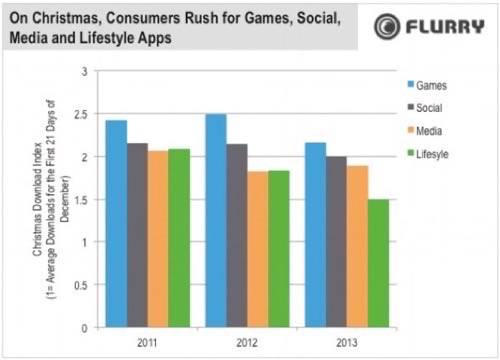The era of exponential growth of smartphones and apps in the United States and other English-speaking countries is beginning to come to an end.
The fact of the matter is that almost everyone in the United States who wants a smartphone or a tablet already has one. The market for mobile devices is filling out at the edges between lower-income individuals and techno-holdouts who are now just getting onto the train to ubiquitous computing. The mobile market in the U.S. is mature.
What does that mean for app developers? On one hand, it means that the installed base of users to download their wares is massive. On the other hand, it means much more competition for user eyeballs, downloads, attentions and overall opportunity.
Data from mobile analytics company Flurry points this out through the lens of Christmas Day. The holiday is the biggest gift-giving day of the year for much of the English-speaking world and over the past several years has been the day with the most smartphone and tablet activations, as people unwrap their shiny new gadgets. In the past couple of years, these people would often be receiving their very first smartphone or tablet ever. The first thing they would do with those new devices would be to go to the various app stores and browse for cool and interesting things to use.

This practice still happens, of course, but not quite like it has in recent years. Many people receiving new gadgets for Christmas are not on their first ever device. Consumers are well familiar with these devices and what they can do. Hence, they likely already have a cadre of trusted apps and services that they will then re-install on their new devices. For instance, if you got a new iPad this year, there is a good chance you just went to iTunes and restored your device from your previous backups on from your old iPad.
Downloads on Christmas day were 11% higher than they were in 2012, according to Flurry. That translates into about 364 million app downloads on Christmas, definitely the biggest day of the year for app developers. That being said, the rate was down from the 36% growth in download volume between 2011 and 2012.

December is one of the biggest download months of the year for developers, but download spikes for the average December day were only 25% greater than the year before, down from 97% between 2011 and 20112.
Flurry’s Mary Ellen Gordon writes:
The biggest growth in mobile now is coming in countries where Christmas is a less significant holiday or not celebrated at all, so new device activations and app downloads come at different times of the year in those places. And because those high-growth areas are joining an already large global market, overall growth rates are less striking than when the mobile market was new.
The biggest lesson here is that the end of the year is still a big target for mobile developers. The Christmas Day spike will continue to be a very real and very relevant day for app developers. But the maturation of the market and the behavior of consumers is beginning to streamline in such a way that it is harder to break through the clutter at any time of the year. As ReadWrite noted late in 2012, the smartphone app gold rush is basically over.

That does not mean there is not opportunity for developers to carve out a niche in the app stores. But just like the gold rush in the U.S. in the mid-to-late 1800s, the opportunities are fewer and further between, sandwiched among entrenched interests that got there first and made their mark.
Lead image courtesy Shutterstock
















